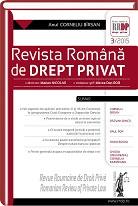Noi aspecte ale aplicării articolelor 41 şi 46 din Convenţie în jurisprudenţa Curţii Europene a Drepturilor Omului
New aspects of the application of articles 41 and 46 of the Convention in the case law of the European Court of Human Rights
Author(s): Corneliu BirsanSubject(s): Law, Constitution, Jurisprudence
Published by: Universul Juridic
Keywords: the European Court of Human Rights; articles 41 and 46 of the Convention; Committee of the Ministers of the Council of Europe; the obligation to enforce the judgments of the Court; restitutio in integrum.
Summary/Abstract: Over a long period, more specifically until the period in the 2000s, the European Court of Human Rights had not set up a relation between the provisions of article 41 and those provided by article 46 of the Convention in its case law, for a clear reason: their matters are completely different. Indeed, article 41 of the Convention empowers the Court to grant “to the injured party”, as the case may be, a just satisfaction, when it finds that there is breach of the Convention and that the domestic law of the Contracting party in question barely imperfectly permit to erase the consequences of the respective breach”. As regards article 46, it sets forth the commitment of the Contracting parties to comply with the final decisions delivered by the Court in those disputes to which they are parties; these judgments are communicated to the Committee of Ministers of the Council of Europe watching over their enforcement. In the European mechanism of the protection of the human rights, the responsibility for watching over the enforcement of these judgments by the Contracting parties does not belong to the Court; this mission was granted to the executive and political body of the Council of Europe under the Convention, namely its Committee of Ministers. Starting from this “legal reality”, first of all, this study highlights the content of the obligation to enforce the judgments of the Court, this content being determined litigation for liability of the Contracting parties for a possible violation of a right guaranteed under the Convention and, at the same time, a dispute for damage for the prejudice thus suffered by the claimant. In any case, the Court shall not directly determine the termination of the effects of the State legal act inseminated under its judgment; it is the responsibility of the State found “guilty” to insure that the consequences of this act shall be prevented. In any case, besides the declaratory and relative nature of the judgments of the Court, the obligation of the States to enforce them has its origin in the commitment they made under article 1 of the Convention to secure everyone within their jurisdiction the rights and freedoms defined in that article. In concrete terms, as regards the application of the provisions of article 41 of the Convention, until the period between 1994 and 1995, the Court had not applied the principle restitutio in integrum in its case law, agreeing that the Contracting parties were free to choose the ways in which the consequences of the breach they had found in relation to claimants, had to be prevented.
Journal: Revista Română de Drept Privat
- Issue Year: 2015
- Issue No: 03
- Page Range: 10-45
- Page Count: 36
- Content File-PDF

